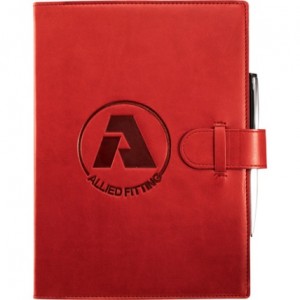In this article we will outline the most popular imprint methods used in the promotional products industry.
Screen Print: By far, the most common imprint method is a screen print. Screen printing is a spot color imprint method. This means that the artwork can have one or more colors, but the graphic consists of solid colors that can be “separated”. Artwork that is screen printed cannot have shading or halftones, and should be one-dimensional. My company’s logo would be a good example of a graphic that could be screen printed as 3 spot colors and how a screen print looks on a USB flash drive:
Screen printing is an economical way to highlight your logo in vivid color on bags, pens, drinkware, and promo products of all kinds.
4-Color Process: This decoration method is used for artwork that is photographic in nature. 4-color process uses very fine halftones and an expanded color range to capture the finest details and sharpness of the design. 4-color process is expensive but if your artwork is photographic than this option will yield optimal results.
Here is an example of a 4-color process imprint on an insulated tote bag and a sport bottle:
Heat Transfer: This decoration method utilizes heat to press (transfer) your imprint into the product material. Heat transfer can be done on many materials and is also used for photographic artwork. This method is less expensive than 4-color process for printing full-color artwork quickly, and therefore is a good option if available.
Deboss: Deboss is a classic imprint method that allows you to leave an impression of your logo onto a material’s surface. This is a popular imprint method for leather or suede products. A die is created and then heat-pressed into the material. A standard deboss uses no color at all. Here is an example of a standard deboss on a travel bag:
A standard deboss is perfect for people who desire a subtle logo appearance – such as when you are using the promotional product as a corporate gift or holiday gift. You want to remind your customer or client who gave you this terrific gift, but it’s not necessarily a marketing tool where you would want your logo to “pop”.
Color Stamp: Another type of deboss is a color stamp. Simple one-color designs are enhanced when a die is used to apply colored foil to a material’s surface. Here is an example of a color stamp on a journal book:
Color Fill: Yet another type of deboss method, first your logo is color stamped onto the material, and then followed by a deboss, with the same die. This method is available only on vinyl patches.
Laser Engrave: This is another very popular imprint method if you would like to achieve a classy, subtle look. Laser engrave gives your logo a clean, polished appearance by precisely etching the artwork into the materials surface. This method is used on metal materials.
Here are examples of a laser etch on a brass pen and a money clip:
Embroidery: This is a traditional method of decorating material with needle and thread. Embroidery gives a “high end” look to your logo but it’s a more expensive decoration method. The cost to embroider your logo is based on the artwork and the item to be embroidered. You must submit your artwork for a stitch count and a custom quote can be created to determine your order costs. Embroidery is often used on apparel.
Here is an example of embroidery on a blanket and a baseball cap:
If you have any questions about this article please contact us at promos@buypromosonline.com.














